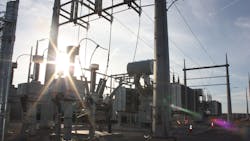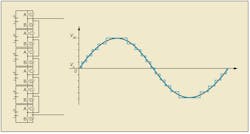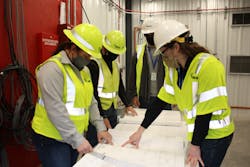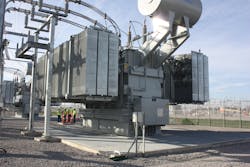Advanced Voltage Control for the Grid
In addition to generating megawatts, fossil fuel energy centers provide reactive power capability through generator excitation systems, thus controlling the transmission system voltage during steady-state and transient conditions. When a plant is retired, in addition to losing the megawatt production, there also is a loss of voltage control, which can lead to system stability issues and violation of North American Electric Reliability Corporation (NERC) standards. Because of its commitment to clean energy and achieving net-zero carbon emissions by 2050, Ameren began planning in 2017 for the retirement of several energy centers within its service territory.
Transient conditions known as fault-induced delayed voltage recovery (FIDVR) events can result in grid instability and loss of customer load. By performing system simulation of FIDVR events along with other transmission system planning studies, the team of planning engineers working with design engineers identified four locations within the Ameren grid that would require transient voltage control devices to continue operating in a steady, reliable manner after the retirement of the coal-fired energy centers.
Specification Development
A team consisting of planning, design, project management, construction and maintenance engineering was formed to develop a specification for the needed voltage control devices, factoring in steady-state and transient performance, initial cost, operations and maintenance cost, safety and long-term sustainability of the technology. Several types of solutions were considered, including synchronous condensers, traditional static volt-ampere-reactive compensator (SVC) systems and STATCOMs.
After reviewing multiple solutions and vendor proposals, the team decided the STATCOM solution best met the requirements of the specification, providing significant performance benefits over SVC and synchronous condensers in terms of increased reactive power capability under transient low- and high-voltage conditions, speed of response and reliability. The STATCOM design, based on voltage source converter and insulated-gate bipolar transistor (IGBT) power electronics, provided the most current technology based on industry-standard power electronic components, thus offering long-term sustainability, a simpler design in terms of system integration (reduced harmonics), and the lowest operation and maintenance costs.
EPC Contract
Ameren determined an engineering, procurement and construction (EPC) contract would be the best approach to installing the STATCOMs, as it had limited knowledge and experience with them. The EPC limited the utility’s risk of having to engineer and install the many integrated parts of the design, such as building requirements, cooling requirements, compatibility and special design issues associated with the step-up transformers and medium-voltage equipment.
While developing the EPC specifications and evaluating bids, an internal Ameren team consisting of project management, engineering, maintenance, operations, legal, quality, safety, and construction supervision groups was formed. The EPC contract was created in two parts: One part was associated with the terms and conditions, developed by legal and project management, and a second part served as the technical scope of work, created by engineering. This two-part EPC contract design was connected through restrictions in the performance guarantee, safety requirements during construction the vendor was required to meet and a five-year warranty period.
The EPC specifications included preferred contractors to meet local economic and union support goals. They also included preferred transformers, high-voltage breakers and switch suppliers to address Ameren’s maintenance requirements.
Included with the EPC specifications were long-term warranty and performance requirements, which encompassed all operations and support needs for the first five years of service, including training internal crews. Performance requirements had to be met for 12 consecutive months within the first three years of operation to receive final performance-based payment.
Project Challenges
Ameren, the manufacturer and contractors faced several challenges together as a team throughout the project. The Ameren project team made several trips to the manufacturer’s facilities to complete design reviews, troubleshooting and maintenance training, and control software simulations. As it was the manufacturer’s first time working with Ameren, the vendor had to learn and become acclimated to the utility’s processes and hands-on involvement.
With members from all around the globe, the diverse team also faced challenges because of different time zones and coordinating work around different holiday schedules during a constrained schedule. The project team worked through these scheduling hurdles by electing an on-call contact for each team and rotating this responsibility to ensure availability and timely responses to keep critical items such as commissioning on schedule.
Shipping was another challenge. Major equipment and materials had to be shipped through customs, sometimes delaying critical items. Because the first two STATCOMs were electrically designed identically, the team was able to substitute the second STATCOM’s materials in place to maintain schedule.
Design and Performance
A STATCOM installation has a relatively small footprint, requiring an area of 250 ft by 250 ft (76 m by 76 m) for a 250-MVAR installation. The power modules and control are located within the building, serving as the basic building block of the STATCOM. Power module stacks are composed of direct-current (dc) capacitors and four IGBT switches per module. The power modules maintain charge on the dc capacitors, which then are gated on and off to increase or decrease the voltage and inject current through a series reactor. The net effect is positive or negative reactive power being injected into the transmission system to regulate system voltage.
For the 250-MVAR design, two 125-MVAR STATCOMS were designed to operate in parallel to optimize system availability and cost. The STATCOMS were designed to continue operating for all N-1 component failures, including valves, cooling pumps and heat exchangers. The system operated on a single control system; however, backup controllers were provided in cold standby to quickly restore operation for a control system failure. Because of the unique design of the step-up transformers, an in-service spare transformer was installed to meet performance requirements.
The first STATCOM was installed at the Stallings substation, close to the Wood River and Fargo substations. The Stallings STATCOM provides transient voltage recovery to a highly industrialized corridor near Wood River, Illinois, U.S., which has a large energy demand and requires stable voltage on the system to ensure manufacturing facilities remain on-line during these contingency events. The Stallings STATCOM has proven to meet high performance standards since its installation in 2019.
The utility has examples of the STATCOM injecting reactive power during an event, limiting the voltage sag to less than 4% and restoring voltage to the pre-event state within 2 seconds. Ameren compared one of these voltage dips before and after the STATCOM was installed. Without the STATCOM, the 138 kV-voltage at Stallings would have dipped to approximately 90% of nominal voltage over an extended period. With the STATCOM, the 138-kV voltage at Stallings was slightly higher than 96% of nominal during the system disturbance.
The STATCOMs have met the performance goals since their installation. However, there were initial issues with STATCOM availability because of cooling system trips and faulty STATCOM module heat sensors. The cooling trips were caused by station service trips during scheduled pump motor transfers, and the heat sensor trips were determined to be a faulty inferred sensor. The manufacturer provided strong technical service by reviewing control system sequence-of-event reports, which were downloaded and provided by Ameren design engineering.
Future Plans
The second STATCOM installation is located at the Beehive substation in Dupo, Illinois, and Meramec switchyard in St. Louis, Missouri. The STATCOM provides transmission support and voltage control to areas impacted by the retirement of Ameren’s Meramec energy center in St. Louis County along the Mississippi River. The Meramec STATCOM also is part of Missouri’s Smart Energy Plan, a multiyear plan that includes more than 2000 projects to upgrade energy infrastructure to support a cleaner and stronger energy grid.
Ameren’s next round of STATCOM installations will be located on weaker parts of the transmission system where N-2 line outage would result in voltage collapse within pockets of load and traditional capacitor banks would not be able to react fast enough. Ameren Transmission’s planning and design departments are actively studying system needs and optimal locations to install even more STATCOMs based on projected coil fire plant shutdowns. It is estimated up to 12 more STATCOM or synchronous condenser locations will be required to meet projected energy center shutdowns over the next 10 years.
Since designing the initial two STATCOM installations, Ameren has incorporated several control system design improvements. More notable enhancements include active filtering and negative sequence current injection. Active filtering reduces harmonics on the system, which may result from higher penetration of inverter-based resources. Negative sequence current injection enables independent control of phase voltage magnitudes, preventing overvoltage of un-faulted phases during FIDVR events caused by line-ground faults. The negative sequence current injection also assists in protective relays, which use negative sequence polarization in determining proper fault detection.
Because of the projected need for additional STATCOMs, Ameren design engineering is working with Ameren Transmission planning and STATCOM manufacturers to develop standard STATCOM sizes and more standard designs, such as standardized transformer size and voltage ratings, which will help to reduce the number of spare parts and spare transformers needed.
STATCOM technology will be integral in supporting Ameren’s goal of reaching net-zero carbon emissions by 2050. In addition to retiring its fossil fuel energy centers, Ameren is planning for its largest-ever expansion of clean wind and solar generation, all while maintaining the reliability and affordability customers have come to expect.
Robert J. Rauschenbach is Ameren Transmission director of electrical design and has over 35 years of experience in design and planning of Ameren’s T&D system. Rauschenbach holds BSEE and MSEE degrees from the University of Missouri Rolla and serves as an adjunct professor at the University of Missouri, St. Louis and Washington University joint engineering program.
Suzanne Pohlman is an Ameren Transmission project manager, leading a team that manages transmission line and substation projects of varying scope and complexity, with capital budgets ranging from several million to over US$200 million. Responsible for some of the most complex and challenging projects in transmission, she holds a BSCM degree from Southern Illinois University – Edwardsville and is an active member on the university’s construction department advisory board.
About the Author
Robert J. Rauschenbach
Robert J. Rauschenbach is Ameren Transmission director of electrical design and has more than 35 years of experience in the design and planning of Ameren's T&D system. He holds a BSEE and MSEE from the University of Missouri Rolla and is also an adjunct professor in the University of Missouri St. Louis and Washington University Joint Engineering Program.





